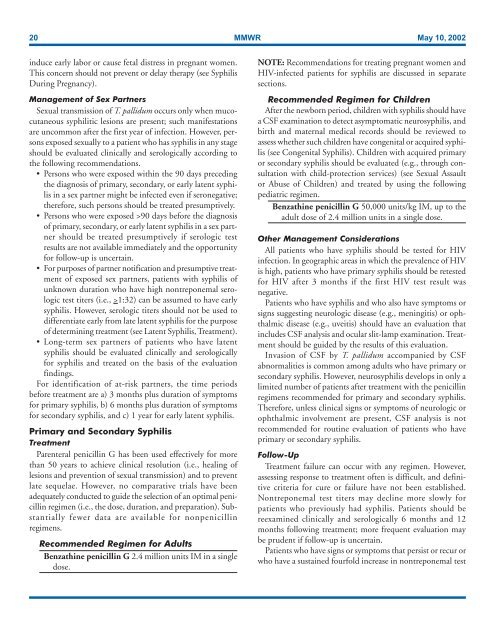Create successful ePaper yourself
Turn your PDF publications into a flip-book with our unique Google optimized e-Paper software.
20 MMWR May 10, 2002<br />
induce early labor or cause fetal distress in pregnant women.<br />
This concern should not prevent or delay therapy (see Syphilis<br />
During Pregnancy).<br />
Management of Sex Partners<br />
Sexual transmission of T. pallidum occurs o<strong>nl</strong>y when mucocutaneous<br />
syphilitic lesions are present; such manifestations<br />
are uncommon after the first year of infection. However, persons<br />
exposed sexually to a patient who has syphilis in any stage<br />
should be evaluated clinically and serologically according to<br />
the following recommendations.<br />
Persons who were exposed within the 90 days preceding<br />
the diagnosis of primary, secondary, or early latent syphilis<br />
in a sex partner might be infected even if seronegative;<br />
therefore, such persons should be treated presumptively.<br />
Persons who were exposed >90 days before the diagnosis<br />
of primary, secondary, or early latent syphilis in a sex partner<br />
should be treated presumptively if serologic test<br />
results are not available immediately and the opportunity<br />
for follow-up is uncertain.<br />
For purposes of partner notification and presumptive treatment<br />
of exposed sex partners, patients with syphilis of<br />
unknown duration who have high nontreponemal serologic<br />
test titers (i.e., >1:32) can be assumed to have early<br />
syphilis. However, serologic titers should not be used to<br />
differentiate early from late latent syphilis for the purpose<br />
of determining treatment (see Latent Syphilis, Treatment).<br />
Long-term sex partners of patients who have latent<br />
syphilis should be evaluated clinically and serologically<br />
for syphilis and treated on the basis of the evaluation<br />
findings.<br />
For identification of at-risk partners, the time periods<br />
before treatment are a) 3 months plus duration of symptoms<br />
for primary syphilis, b) 6 months plus duration of symptoms<br />
for secondary syphilis, and c) 1 year for early latent syphilis.<br />
Primary and Secondary Syphilis<br />
Treatment<br />
Parenteral penicillin G has been used effectively for more<br />
than 50 years to achieve clinical resolution (i.e., healing of<br />
lesions and prevention of sexual transmission) and to prevent<br />
late sequelae. However, no comparative trials have been<br />
adequately conducted to guide the selection of an optimal penicillin<br />
regimen (i.e., the dose, duration, and preparation). Substantially<br />
fewer data are available for nonpenicillin<br />
regimens.<br />
Recommended Regimen for Adults<br />
Benzathine penicillin G 2.4 million units IM in a single<br />
dose.<br />
NOTE: Recommendations for treating pregnant women and<br />
HIV-infected patients for syphilis are discussed in separate<br />
sections.<br />
Recommended Regimen for Children<br />
After the newborn period, children with syphilis should have<br />
a CSF examination to detect asymptomatic neurosyphilis, and<br />
birth and maternal medical records should be reviewed to<br />
assess whether such children have congenital or acquired syphilis<br />
(see Congenital Syphilis). Children with acquired primary<br />
or secondary syphilis should be evaluated (e.g., through consultation<br />
with child-protection services) (see Sexual Assault<br />
or Abuse of Children) and treated by using the following<br />
pediatric regimen.<br />
Benzathine penicillin G 50,000 units/kg IM, up to the<br />
adult dose of 2.4 million units in a single dose.<br />
Other Management Considerations<br />
All patients who have syphilis should be tested for HIV<br />
infection. In geographic areas in which the prevalence of HIV<br />
is high, patients who have primary syphilis should be retested<br />
for HIV after 3 months if the first HIV test result was<br />
negative.<br />
Patients who have syphilis and who also have symptoms or<br />
signs suggesting neurologic disease (e.g., meningitis) or ophthalmic<br />
disease (e.g., uveitis) should have an evaluation that<br />
includes CSF analysis and ocular slit-lamp examination. Treatment<br />
should be guided by the results of this evaluation.<br />
Invasion of CSF by T. pallidum accompanied by CSF<br />
abnormalities is common among adults who have primary or<br />
secondary syphilis. However, neurosyphilis develops in o<strong>nl</strong>y a<br />
limited number of patients after treatment with the penicillin<br />
regimens recommended for primary and secondary syphilis.<br />
Therefore, u<strong>nl</strong>ess clinical signs or symptoms of neurologic or<br />
ophthalmic involvement are present, CSF analysis is not<br />
recommended for routine evaluation of patients who have<br />
primary or secondary syphilis.<br />
Follow-Up<br />
Treatment failure can occur with any regimen. However,<br />
assessing response to treatment often is difficult, and definitive<br />
criteria for cure or failure have not been established.<br />
Nontreponemal test titers may decline more slowly for<br />
patients who previously had syphilis. Patients should be<br />
reexamined clinically and serologically 6 months and 12<br />
months following treatment; more frequent evaluation may<br />
be prudent if follow-up is uncertain.<br />
Patients who have signs or symptoms that persist or recur or<br />
who have a sustained fourfold increase in nontreponemal test


